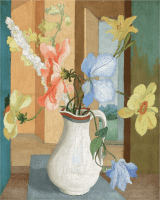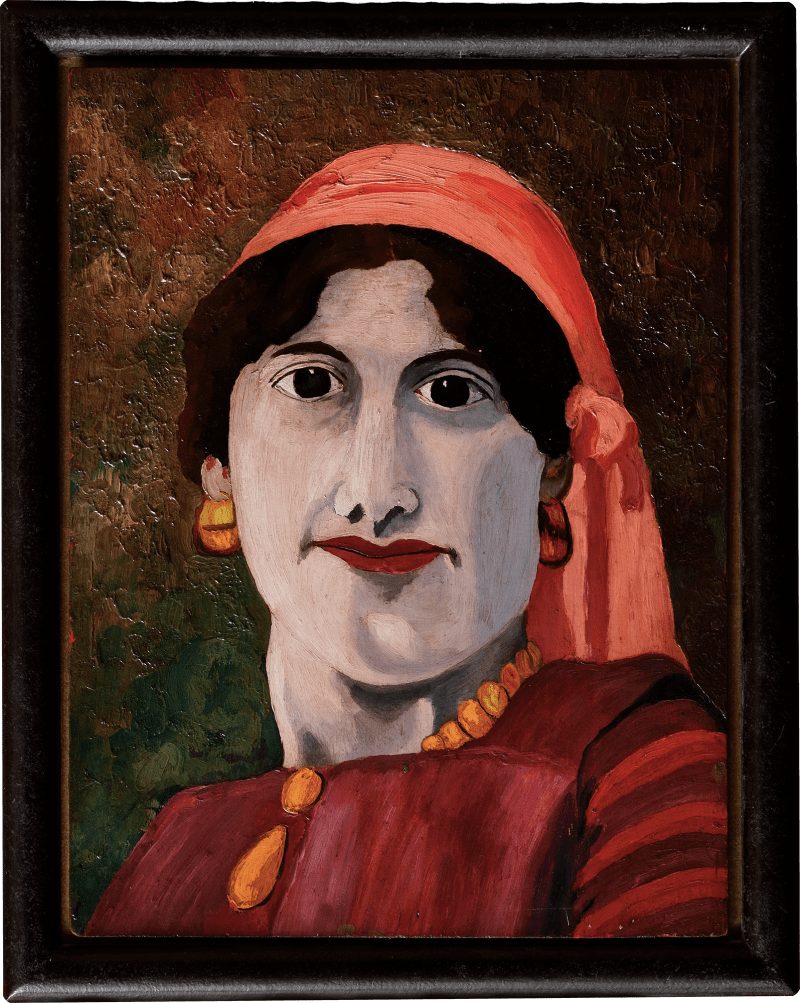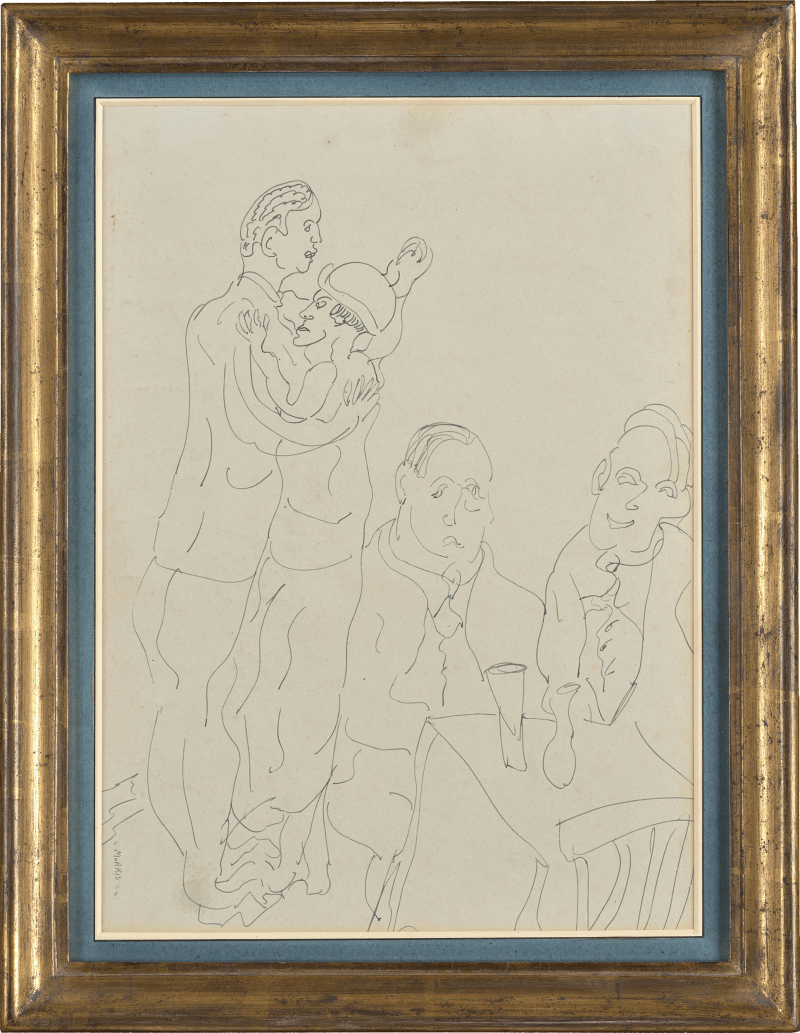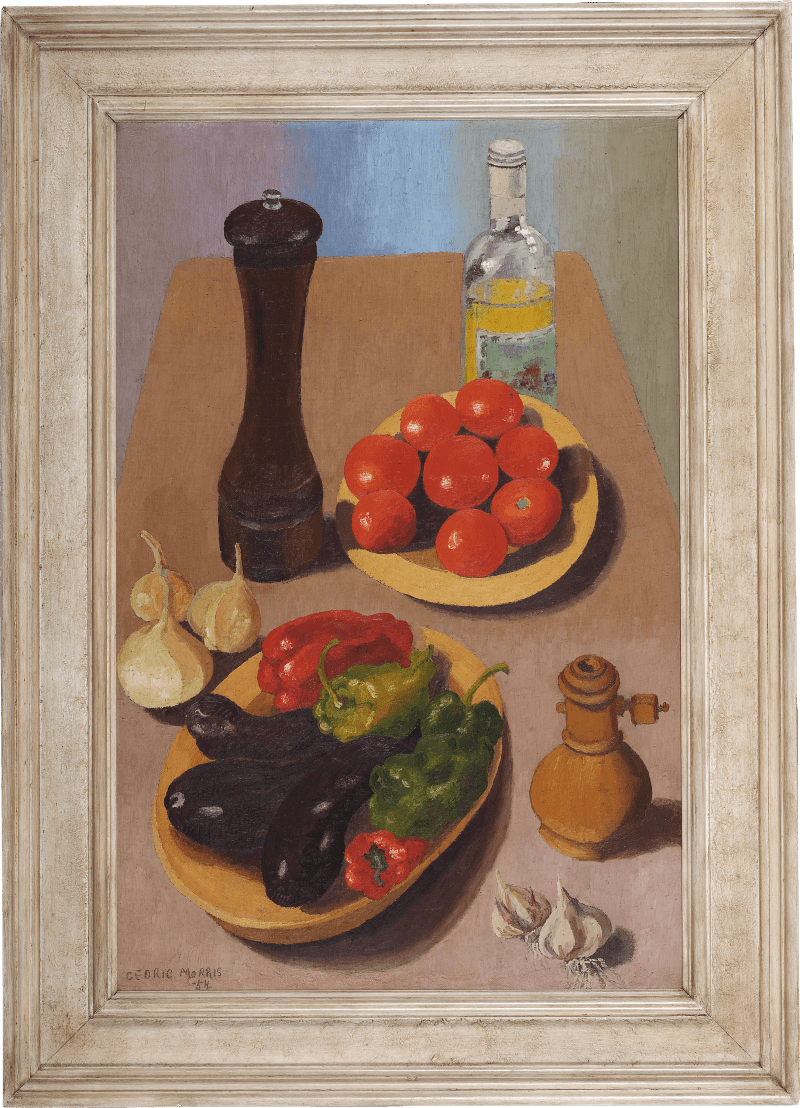Cedric Morris is regarded as one of the most talented and original flower painters of the early twentieth century. This animated still-life, notable for its distinctly modernist approach to colour and composition, was painted at Benton End during the Second World War and is an exceptional example of his work from this period of artistic experimentation.
Throughout the 1920s and 30s, Morris generally depicted his floral subjects against a neutral backdrop, but during the wartime years, he explored and expanded his compositional designs by placing his still-lifes within interior settings. The present work is an ambitious work from this period and the background is so angular that it appears almost abstract. On close inspection, one can see how meticulously he planned these elements with each line drawn in pencil before the paint was applied. This is a clear departure from his style of painting in the 1930s which rarely involved any preparatory drawing whatsoever. A further distinguishing feature of...
Cedric Morris is regarded as one of the most talented and original flower painters of the early twentieth century. This animated still-life, notable for its distinctly modernist approach to colour and composition, was painted at Benton End during the Second World War and is an exceptional example of his work from this period of artistic experimentation.
Throughout the 1920s and 30s, Morris generally depicted his floral subjects against a neutral backdrop, but during the wartime years, he explored and expanded his compositional designs by placing his still-lifes within interior settings. The present work is an ambitious work from this period and the background is so angular that it appears almost abstract. On close inspection, one can see how meticulously he planned these elements with each line drawn in pencil before the paint was applied. This is a clear departure from his style of painting in the 1930s which rarely involved any preparatory drawing whatsoever. A further distinguishing feature of this work is the title ‘September Diagram’ which is remarkably conceptual, even within the context of his other still-life works from this experimental period. A diagram can be defined as a visual representation of an idea or object in graphical form, and in this instance, Morris has used a floral arrangement to symbolise the month of September, possibly in reference to the passing of summer into autumn.
From their home Benton End, Morris and his partner Arthur Lett-Haines ran the East Anglian School of Painting and Drawing which at this date was an energetic hive of activity with numerous young, ambitious artists passing through its doors. One such painter was Lucian Freud who later recalled with great fondness his time spent studying with Morris during the early wartime years. Contrary to more popular approaches in art schools at that date, Morris and Lett remained adamant that each student’s distinctive technique and vision should be nurtured. Art Historian Richard Morphet incisively notes that ‘Rather than an academy, the School was a community that in practice taught not only art but also the art of living.’[1] As such, the school attracted contemporary creatives, such as the author Ronald Blythe, who fondly recalled his visits to Benton End;
I always retain a composite Monet-like vision of Benton End on a summer's afternoon just before the tea bell, with students, roses, easels, cats, iris, beds, labyrinthine paths, secretive walls, and multifarious palettes all joined in a conspiracy of colour and light.[2]
Blythe’s description of Benton End on a summer’s day pairs perfectly with the present still life which encapsulates the tangled interior spaces brought alive with colour and scent.
On the reverse of this painting is an unfinished portrait which was abandoned and then briskly painted over. Canvas was an expensive luxury, especially during the wartime years, and it was not uncommon for Morris to recycle canvases. It remains a mystery as to why the portrait was never finished, but the critic, Raymond Mortimer, once deftly called Morris’ portraits ‘not a speaking but a shrieking likeness’.[3] Although hard to see through the paint layers above, it is clear that the uncompromising portrait (or what is left of it) is indeed a disparate world away from the perfectly arranged pastel blooms painted on the other side of the canvas.
Benton End embodied the union of Morris’ lifelong passions – painting and gardening. Unparalleled in his horticultural understanding of his subject matter, Morris imbues his flower paintings with a distinguishing familiar honesty. Expertly arranged, Morris delicately renders the papery petals of a large blue Clematis in powder blue pigments and mirrors the central bloom with an equally delicate pink Clematis. This central arrangement is flanked by two yellow Dahlias and another blue Clematis, reaching down toward the table. A Foxglove (Yellow Digitalis Grandiflora) and White Mullein (Verbascum) on the left compositionally balance the proud Yellow Day Lily (Hemerocallis) which protrudes high above the arrangement on the right.[4] These organic and honest forms contrast with the geometric, almost surreal backdrop; the natural and individual characters of each flower are set within a modernist setting governed by liner compartmentalisation. This union of two seemingly distinct genres distinguishes many of Morris’ paintings from this period.
[1] Richard Morphet, (2002) Benton End Remembered. Norwich: Unicorn Press, p.5.
[2] Roland Blythe, quoted in Christopher Neve, ‘A Painter and his Garden: Cedric Morris at Benton End’, Country Life, Vol. 165 (4271), May 17, 1979, p.1534.
[3] Richard Mortimer, quoted in Christopher Neve, ‘A Painter and his Garden: Cedric Morris at Benton End’, Country Life, Vol. 165 (4271), May 17, 1979, p.1534.
[4] We are grateful to Clive Lundquist for identifying these species.















